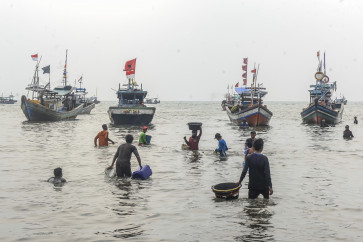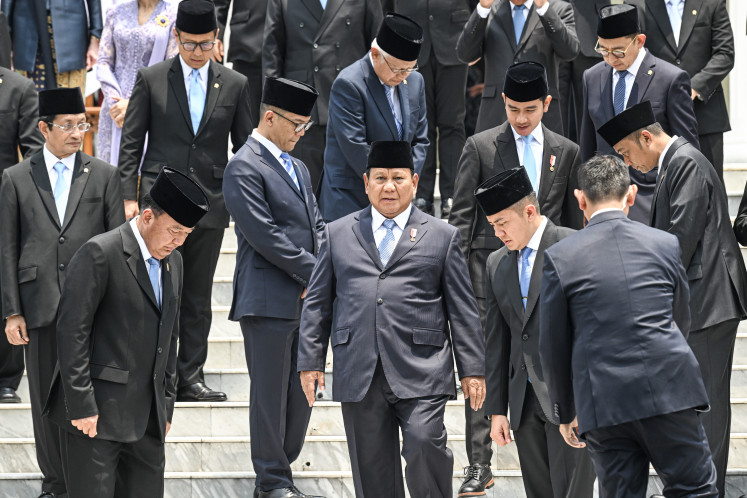Popular Reads
Top Results
Can't find what you're looking for?
View all search resultsPopular Reads
Top Results
Can't find what you're looking for?
View all search resultsResidents encouraged to save water through biopores system
While development of reservoirs and infiltration wells is said to be one of the best possible solutions to flooding in the capital, only a few realize that flood prevention can simply start in residents’ backyards through the development of biopores, a rainwater harvesting system
Change text size
Gift Premium Articles
to Anyone
W
hile development of reservoirs and infiltration wells is said to be one of the best possible solutions to flooding in the capital, only a few realize that flood prevention can simply start in residents’ backyards through the development of biopores, a rainwater harvesting system.
On Friday, dozens of interior design students from Pelita Harapan University (UPH) in Karawaci, Tangerang, disseminated knowledge about biopores to students of the Alternative School for Street Children (SAAJA) in Karet Kuningan, Setiabudi, South Jakarta.
Assisted by their lecturer, Ruth Oppusunggu, the students explained the water retention method to the kindergarten children and their parents through games and discussions.
Not only were they taught about biopores in theory, the children and their parents also learned to install four biopores in the school’s backyard.
The students decided to install biopores in SAAJA’s backyard, where puddles often accumulate during the rainy season.
One of the UPH students, Viliantie Siswanto, told the children’s parents about the importance of using water wisely and the function of biopores.
Given that Jakarta-owned water company PAM Jaya’s service only covers 60 percent of Jakarta’s residents, a lot of people rely on groundwater to fulfill their everyday water needs.
“We can use groundwater, but we have to put the water back in the ground. We can do that by installing pipes with small holes underground,” Viliantie said during the event.
Biopores are believed to be useful to mitigate puddles during the rainy season as they can increase the soil’s ability to absorb water.
Design as Generator (DAG), a group of designers and lecturers that focuses on empowering the community through a sustainable and participatory design approach, says a biopore hole can absorb and save 180 liters and 45 L of rainwater per hour, respectively.
The residents can make a biopore by installing a perforated pipe about 1.2 meters underground and filling the pipe with organic waste.
After three months, the waste, which will have turned into compost, should be collected. The waste can be easily collected with a tool shaped like a long ladle.
Ruth, who is also a cofounder of DAG, said she had introduced a movement to the children to build their awareness about the importance of saving water.
She said she believed raising the awareness of children was easier than with adults, whose habits and attitudes have already been established.
Previously, Ruth participated in a movement to install biopores in 100 spots in Greater Jakarta, but she found out later that there were only two biopores that were still functional.
“We have altered our focus to the children, not to adults in kampung areas, because we believe children will remember our message,” Ruth said.
She added that the movement targeted lower-income people because they were the ones who often faced difficulty accessing clean water. Jakarta Environment Agency deputy head Ali Maulana said there were about 4,000 biopores in the capital.
The city administration has encouraged residents to install biopores in the last 10 years in a bid to mitigate and prevent flooding in the city, he said.
“Compared to developing infiltration wells, making a biopore is so easy and affordable because residents only need to buy pipes,” he said.
Ali said the agency would keep disseminating information about biopores to the residents.










